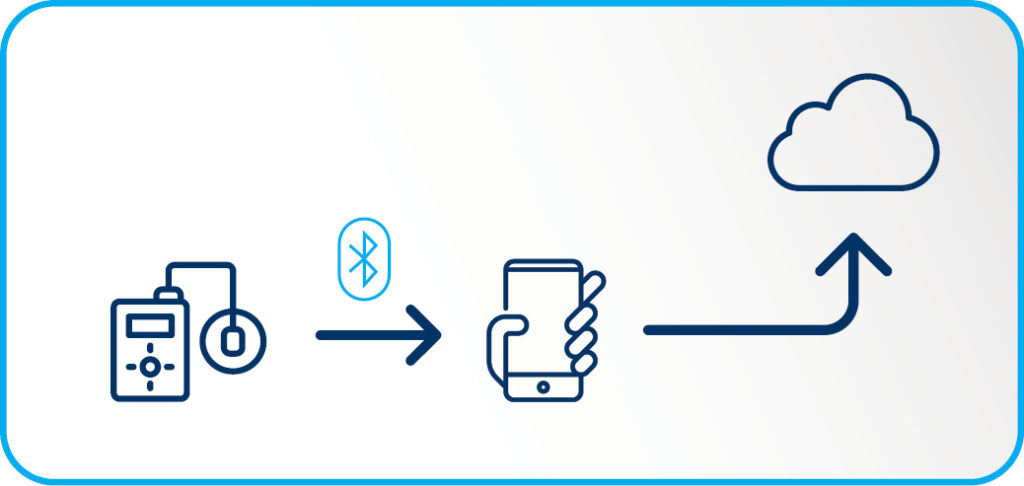By Igor Tovberg, Director of Product Marketing, Sony Semiconductor IL
In the next few years, fundamental technological changes in wireless communications are set to revolutionize healthcare applications. Mobile health devices can assist in reducing hospital costs, enabling better clinical decision-making, getting patients more exposed to their medical conditions and treatment, and even saving lives. The global mHealth solutions market is projected to reach USD 213.6 billion by 2025 from USD 50.8 billion in 2020, and we can see more and more tech giants like Apple and Google pushing their way to healthcare. In this blog, we will explore how professional organizations can benefit from the connectivity options available for healthcare application devices.
Traditional connected healthcare device design
Monitoring healthcare applications has traditionally focused on the patient as the single object for receiving the data captured. Therefore, it only made sense to use the patient’s smartphone as a means of receiving the data over a Bluetooth Low Energy (BLE) connection, processing it, and using the built-in connectivity in the smartphone to send the data externally to the cloud (as depicted in Figure 1 below). Additional topologies leveraged existing WiFi infrastructure, mandating a local router in between the device and the network.

Technological Progress in Cellular LPWAN Connectivity
Recently, a lot of progress has been made to enable seamless connectivity for IoT devices, particularly in the cellular IoT standards (LTE-M and NB-IoT) are inherently built for resource-constrained IoT devices, allowing long battery life, small size to fit compact, low-cost devices, making them ideal for healthcare applications.
Today, as healthcare devices for blood pressure, glucose monitoring, Holter monitors etc. evolve to provide better, more accurate data, doctors can effectively monitor patient status remotely from their own homes and advise on the right treatment in the same way the patient was monitored in the hospital. In fact, hospitals are seeking the technological capabilities to enable patients to be hospitalized from their own homes for convenience and to reduce the load of hospital bed occupancy (which has become painfully visible during COVID-19 with the stress on hospital beds).

Removing dependency on the human factor with cellular IoT connectivity
It’s time for a rethink. Is the conventional topology of using WiFi/BLE connectivity for healthcare devices still the right choice for the value we want to get out of healthcare data? Or will a direct link between the healthcare device and the cloud (as depicted in Figure 2) be better?
As always, it depends on the use case and application.
Visual representation of the measured data is easily accessible to the patient in both BLE (directly from the device) or Cellular (via the cloud) connectivity options. For applications that use the patient’s smartphone as the primary interface to control the device, it makes sense to continue using BLE, as the dependency on the patient’s smartphone is inherent. However, to take the next step in the evolution of healthcare services, devices need to be always on, always-connected, which means data needs to be shared simply, reliably, and securely.
Let’s review conventional BLE connectivity vs. cellular IoT connectivity in these terms:
Simplicity
When using WiFi/BLE connectivity, getting a device to be functional is also dependent on the patient. Usually, the vendor provides an installation app and the user needs to follow the instructions. This process is not always intuitive and often leads to the device not operating correctly and to user frustration.
Cellular LPWAN offers out-of-the-box plug and play connectivity. There is no dependency on human intervention for pairing purposes as in the BLE case. Nor is there any dependency on the condition of the patient’s smartphone or the need for seeking a proper SSID and pairing as in the WiFi case. Cellular-based device powers on and immediately connects to the network. This is especially valuable to the elderly, kids or other patients with limitations who may struggle to set up the device correctly.
Reliability
In the BLE case, the device relies on the patient’s smartphone to communicate the data. This presents several challenges: The phone is not always accessible (due to a depleted battery, broken or stolen phone or simply because the phone’s BLE function is turned off) and is dependent on the patients (who might be less tech savvy) to operate the phone app in the right way to get the data across. Reliable cellular connectivity is not disrupted by human interaction as may occur in BLE case.
With strong support by Mobile Network operators, Cellular IoT has been rapidly deployed, providing global and reliable coverage now, and it is here to stay with operator support for decades ahead. According to GSMA (https://www.gsma.com/iot/mobile-iot-commercial-launches/ ), more than 150 commercial networks are already supporting Cellular IoT.
Using cellular IoT, valuable information can be sent, continuously and on real time, not only to the patient himself, but also to the family care provider or to emergency services if needed.
Security
When using BLE, data delivery relies on the smartphone application. This can present various threats as smartphone apps are generally more vulnerable to different types of attacks which jeopardize secure and reliable delivery of the data to the cloud.
Cellular IoT has the highest security standards, with end-to-end authentication of the trusted secure element (SIM level authentication) to the operator. It also enables direct cloud communication to ensure reliable and secure delivery of the data.
Conclusion
For healthcare applications that require the patient’s mobile phone to actively operate the device, it makes sense to continue using the patient’s mobile phone as a gateway to the network. However, in most other cases, this dependency is cumbersome and can even risk lives in cases where the BLE link to mobile phone is inaccessible for any reason. To ensure secured, reliable, continuous connectivity, it is preferable to use cellular IoT networks that are largely deployed with outstanding coverage in almost any environment worldwide. Using cellular LPWAN technology also removes the burden of device installation from the patient, making it a plug and play device with out-of-the box connectivity.